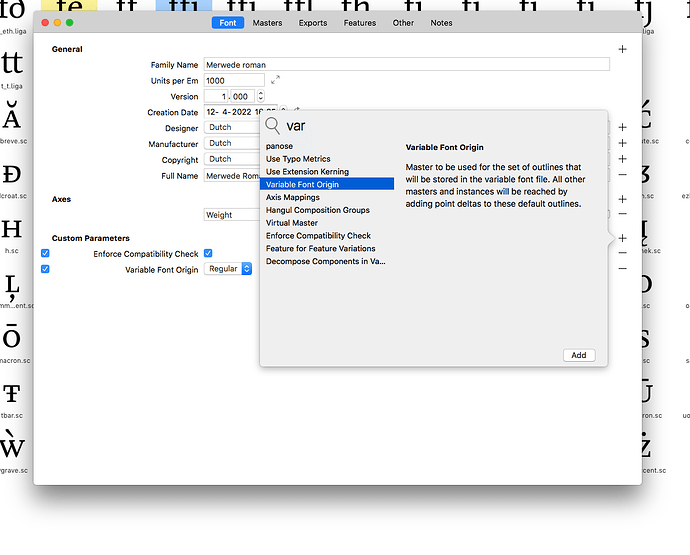Hello Glyphs,
A time ago, a tutorial told me to add this parameter. Checking these things now, I wonder why. I don’t understand this parameter. Is it useful and necessairy? My roman and italic fonts consists of regular, bold and an interpolated medium.
Thank you
It’s useful, but not mandatory, to specify the default instance for display in apps.
If not set, Glyphs will default the VF Origin to your first instance (Please correct me if I’m wrong) but usually it’s common use Regular as origin.
This determines the default instance of your font show in apps.
Precision: If the parameter is not set, the instance corresponding to the first master in the font will be set as the instance displayed by default. If you do not have an instance that corresponds to your font’s first master/variable font origin, an extra “Regular” instance (or similar) will be displayed in most layout apps, leading to conflicts, so be sure to have a corresponding instance defined.
On a technical level, the variable font origin defines the master of which the outlines are used to compute the other outlines, since a variable font only contains one set of outlines and then only descriptions of how to change these original node positions to achieve the other “masters”. The term “multiple-master font” is thus not the same, as variable fonts contain only one master’s outlines and deltas (difference descriptions).
All right, so it’s a good thing to use this parameter. The regular (first master) is now my origin and is shown in apps.
In addition, (AFAIK) If the first or last master is selected as the Variable Font Origin, the file size of the generated variable font can be kept to a minimum, because the node positions of the other instances are stored as single value data sets, either forward “or” backward. Otherwise, if one in the middle (of a three master setup) is chosen as the first master, the file size is likely to double, since a single node position data must contain both forward “and” backward values. (/AFAIK).
I don’t think so. If you have three masters in a row, it shouldn’t make much difference where you put the origin.
You can only choose a master as origin, not an instance.
Only if you want to specify a different variable origin than the first master in the font.
It’s redundant to add the parameter if you set the first master as the variable font origin. That’s the default anyway.
All right, so it’s not necessary. To use the first master (regular) as the origin seems natural. (Why use the bold as origin?)
Thanx
There are two considerations. The origin determines what you see in places that do not support variable fonts. And it depends on the master setup with multiple axis.
